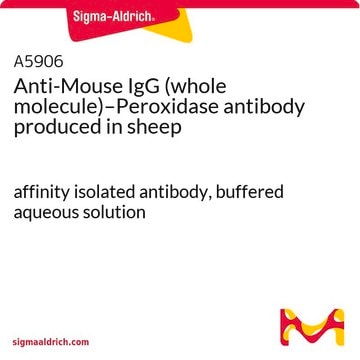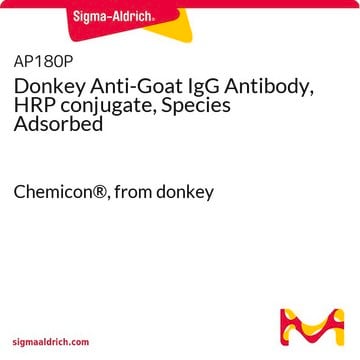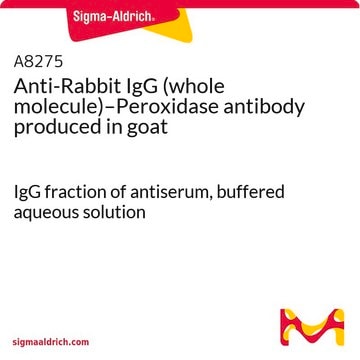GENA934-1ML
Rabbit IgG HRP Linked Whole Ab
Cytiva NA934-1ML
Synonym(s):
Rabbit IgG Antibody
Sign Into View Organizational & Contract Pricing
All Photos(1)
About This Item
UNSPSC Code:
12352203
NACRES:
NA.76
Recommended Products
conjugate
peroxidase conjugate
antibody form
F(ab′)2 fragment of affinity isolated antibody
antibody product type
secondary antibodies
feature
wetted part: no
packaging
pkg of 1 mL
manufacturer/tradename
Cytiva NA934-1ML
color
Brown (light)
shipped in
wet ice
storage temp.
2-8°C
General description
Horseradish peroxidase conjugated antibody is supplied in phosphate buffered saline (sodium phosphate 0.1 M, NaCl 0.1 M) pH 7.5, containing 1% (w/v) bovine serum albumin and an anti-microbial agent.
The antibodies are supplied with dilution guidelines for relevant applications and should be stored at 2° C to 8° C.
The antibodies are supplied with dilution guidelines for relevant applications and should be stored at 2° C to 8° C.
Features and Benefits
- Highly species-specific.
- Optimized for use with our range of ECL™ Detection Reagents.
- Recommended dilutions to minimize background.
Storage and Stability
Please be aware this product may be shipped 90 days before the expiration date. For more information on the batch specific expiration date, please contact technical service.
Analysis Note
To view the Certificate of Analysis for this product, please visit www.cytiva.com.
Legal Information
ECL is a trademark of Cytiva
Not finding the right product?
Try our Product Selector Tool.
Storage Class Code
12 - Non Combustible Liquids
Certificates of Analysis (COA)
Search for Certificates of Analysis (COA) by entering the products Lot/Batch Number. Lot and Batch Numbers can be found on a product’s label following the words ‘Lot’ or ‘Batch’.
Already Own This Product?
Find documentation for the products that you have recently purchased in the Document Library.
Customers Also Viewed
R Kelly Dawe et al.
Cell, 173(4), 839-850 (2018-04-10)
Maize abnormal chromosome 10 (Ab10) encodes a classic example of true meiotic drive that converts heterochromatic regions called knobs into motile neocentromeres that are preferentially transmitted to egg cells. Here, we identify a cluster of eight genes on Ab10, called
Morayma M Temoche-Diaz et al.
Bio-protocol, 10(15), e3706-e3706 (2021-03-05)
Small extracellular vesicles (sEVs) encompass a variety of distinct vesicles that are secreted to the extracellular space. Many methodologies currently used for EV isolation (e.g., differential ultracentrifugation concluding in a high-speed pellet, precipitation by macromolecular crowding agents or size excusion
Na Wang et al.
Genetics, 217(4) (2021-04-16)
Centromeres are defined by the location of Centromeric Histone H3 (CENP-A/CENH3) which interacts with DNA to define the locations and sizes of functional centromeres. An analysis of 26 maize genomes including 110 fully assembled centromeric regions revealed positive relationships between
Shiqi Xiang et al.
Stem cell research & therapy, 12(1), 347-347 (2021-06-16)
Human bone marrow-derived mesenchymal stem cells (hBMSCs) can differentiate into adipocytes upon stimulation and are considered an appropriate cell source for adipose tissue engineering. In addition to biochemical cues, the stiffness of a substrate that cells attach to has also
Baptiste Coxam et al.
Development (Cambridge, England), 149(6) (2022-03-22)
Molecular mechanisms controlling the formation, stabilisation and maintenance of blood vessel connections remain poorly defined. Here, we identify blood flow and the large extracellular protein Svep1 as co-modulators of vessel anastomosis during developmental angiogenesis in zebrafish embryos. Both loss of
Our team of scientists has experience in all areas of research including Life Science, Material Science, Chemical Synthesis, Chromatography, Analytical and many others.
Contact Technical Service








